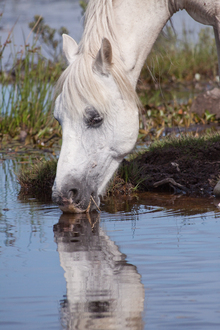Equine Protozoal Myeloencephalitis (EPM) is a master of disguise. This serious disease can be difficult to diagnose because its signs often mimic other health problems in the horse and signs can range from mild to severe.

Horse exposure through parasite contaminated water
More than 50 percent of all horses in the United States may have been exposed to the organism that causes Equine Protozoal Myeloencephalitis.
EPM was first recognized in the 1970s. In recent years, awareness among veterinarians and horse owners has grown considerably. Research at the University of Kentucky, the University of Florida, Ohio State University, the University of California at Davis, and Michigan State University, as well as Bayer Animal Health and other institutions, is leading to advancements in EPM diagnosis and treatment.
More than 50 percent of all horses in the United States may have been exposed to the organism that causes EPM. The causative organism is a protozoal parasite named Sarcocystis neurona. The disease is not transmitted from horse to horse.
Rather, the protozoa are spread by the definitive host the opossum. The infective stage of the organism, the sporocysts, are passed in the opossum's feces. The horse comes into contact with the infective sporocysts while grazing or eating contaminated feed or drinking water.
Once ingested, the sporocysts migrate from the intestinal tract into the bloodstream and cross the blood/brain barrier. There they begin to attack the horse's central nervous system. The onset of the disease may be slow or sudden. If left undiagnosed and untreated, EPM can cause devastating and lasting neurological damage.
The clinical signs of EPM can be quite varied. Clinical signs are almost always asymmetrical (not the same on both sides of the horse). Actual signs may depend on the severity and location of the lesions that develop in the brain, brain stem or spinal cord. Signs may include:
- Ataxia (incoordination),
- Spasticity, stiff, stilted movements, abnormal gait or lameness
- Incoordination and weakness which worsens when going up or down slopes or when head is elevated
- Muscle atrophy, most noticeable along the topline or in the large muscles of the hindquarters, but can sometimes involve the muscles of the face or front limbs
- Paralysis of muscles of the eyes, face or mouth, evident by drooping eyes, ears or lip
- Difficulty swallowing
- Seizures or collapse
- Abnormal sweating
- Loss of sensation along the face, neck or body
- Head tilt with poor balance; horse may assume a splay-footed stance or lean against stall walls for support
Three things seem to influence progression of the disease:
- The extent of the infection (i.e. the number of organisms ingested)
- How long the horse harbors the parasite prior to treatment
- The point(s) in the brain or spinal cord where the organism localizes and damage occurs
